10 Ways to Leverage Technographic Data for Market Insights

10 Ways to Leverage Technographic Data for Market Insights
Overview
This article examines how businesses can effectively leverage technographic data to gain valuable market insights and enhance their marketing strategies. By utilizing such data, companies can achieve precise customer segmentation, which allows for targeted outreach and improved decision-making. These advantages ultimately lead to increased engagement and growth opportunities within a competitive landscape.
How can your business benefit from integrating technographic data into its marketing efforts? The insights gained from this data not only inform marketing strategies but also empower businesses to make informed decisions that drive success.
Introduction
Unlocking the secrets of technographic data presents a significant opportunity for businesses navigating the complexities of today’s market landscape. By analyzing the technology stacks of competitors and potential clients, organizations can tailor their marketing strategies, enhance customer segmentation, and drive targeted outreach efforts. However, a critical question arises: how can companies effectively harness this data to not only stay ahead of the competition but also anticipate market trends and meet evolving customer needs? This article explores ten innovative ways to leverage technographic data for actionable market insights, empowering businesses to refine their strategies and achieve sustainable growth.
Initial Data Offering: Access Comprehensive Technographic Datasets
Initial Data Offering (IDO) serves as a crucial resource for accessing extensive datasets that provide in-depth insights into the toolsets utilized by various organizations. These datasets enable businesses to make informed decisions that align with current market trends. For example, 66% of B2B marketers leverage technographic data to identify competitive opportunities, highlighting the significance of these datasets in strategic planning. Moreover, 75% of B2B customers expect personalized messaging based on their technology use, emphasizing the need for companies to tailor their marketing strategies effectively.
Industry leaders underscore the transformative possibilities of technological information. Marissa Mayer points out that early information gathering can yield significant insights, while Geoffrey Moore asserts that such insights are essential for making informed business decisions. Successful applications of technographic information have demonstrated that understanding competitors' technology utilization not only aids in identifying potential clients but also enhances market positioning. By utilizing IDO's high-quality information, businesses can refine their marketing strategies, ultimately driving growth and maintaining a competitive advantage in an ever-evolving landscape.
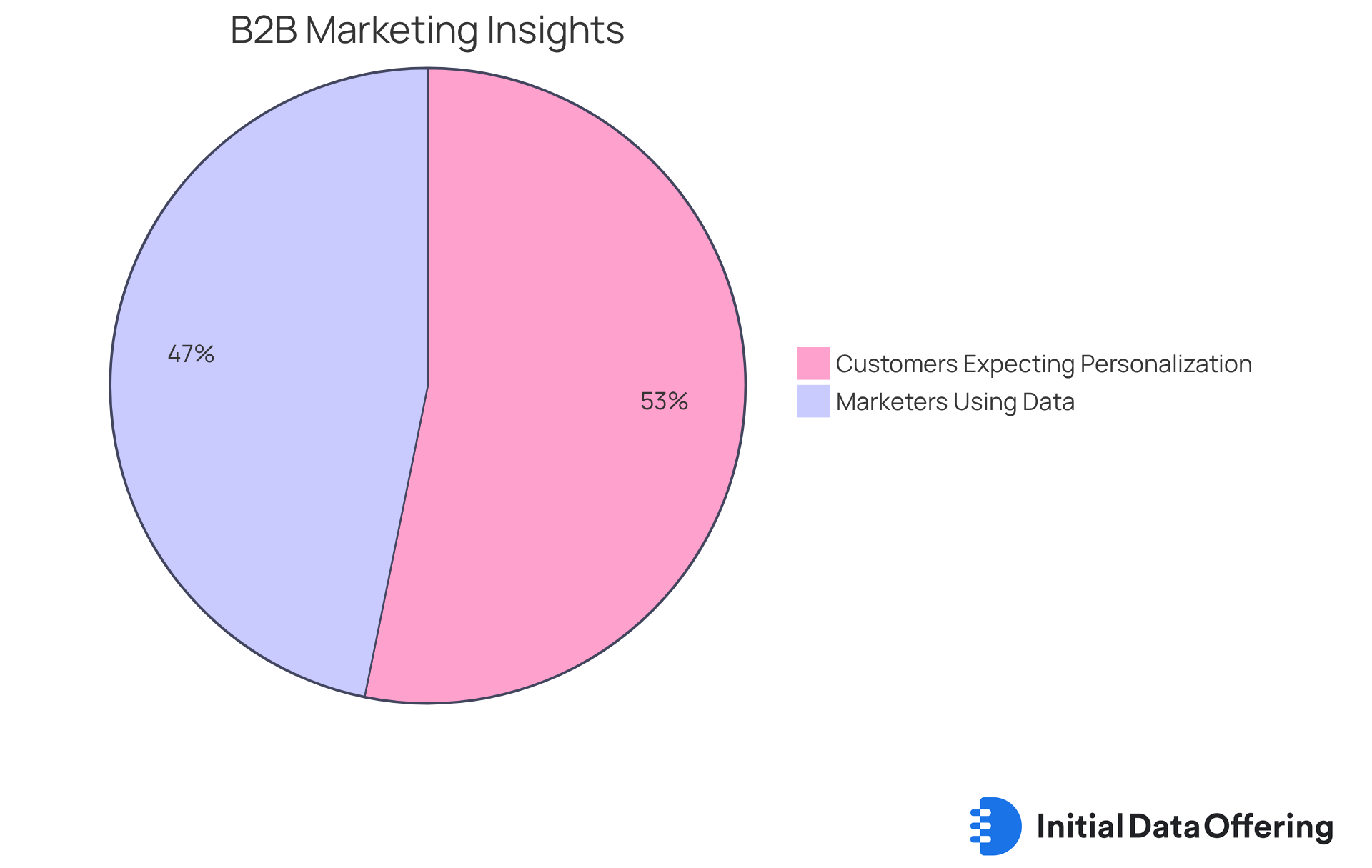
Precise Customer Segmentation: Tailor Marketing Strategies Effectively
Leveraging technographic insights empowers businesses to achieve highly precise customer segmentation. This dataset allows companies to analyze the tools employed by prospective clients, enabling them to classify their audience based on particular requirements and preferences. The advantage of this customized method lies in its ability to facilitate the development of focused marketing plans that resonate with specific segments, ultimately improving engagement and conversion rates. For instance, a software firm can identify organizations reliant on obsolete systems and strategically position its solutions as crucial enhancements, thereby boosting the chances of acceptance.
Case studies, such as Salesforce's success in leveraging technographic data, illustrate that companies employing targeted approaches have experienced significant increases in conversion rates. Customized outreach has resulted in an average boost of 80% in engagement. Marketing specialists emphasize that comprehending the landscape of target accounts is essential for crafting effective marketing and sales strategies. As a marketing specialist from Demandbase notes, 'Understanding technographic information is crucial for comprehending the tech environment of your target accounts, enabling more accurate and efficient marketing and sales strategies.'
Moreover, with worldwide IT expenditure projected to increase by 9.3% in 2025, the significance of technology-related data in the current market environment cannot be overstated. Tools such as Datanyze and BuiltWith provide valuable insights into the tech stacks of potential clients, allowing companies to refine their marketing strategies.
How can your business leverage technographic data to enhance its outreach efforts? By understanding the technological landscape of your target accounts, you can create more tailored and effective marketing initiatives.
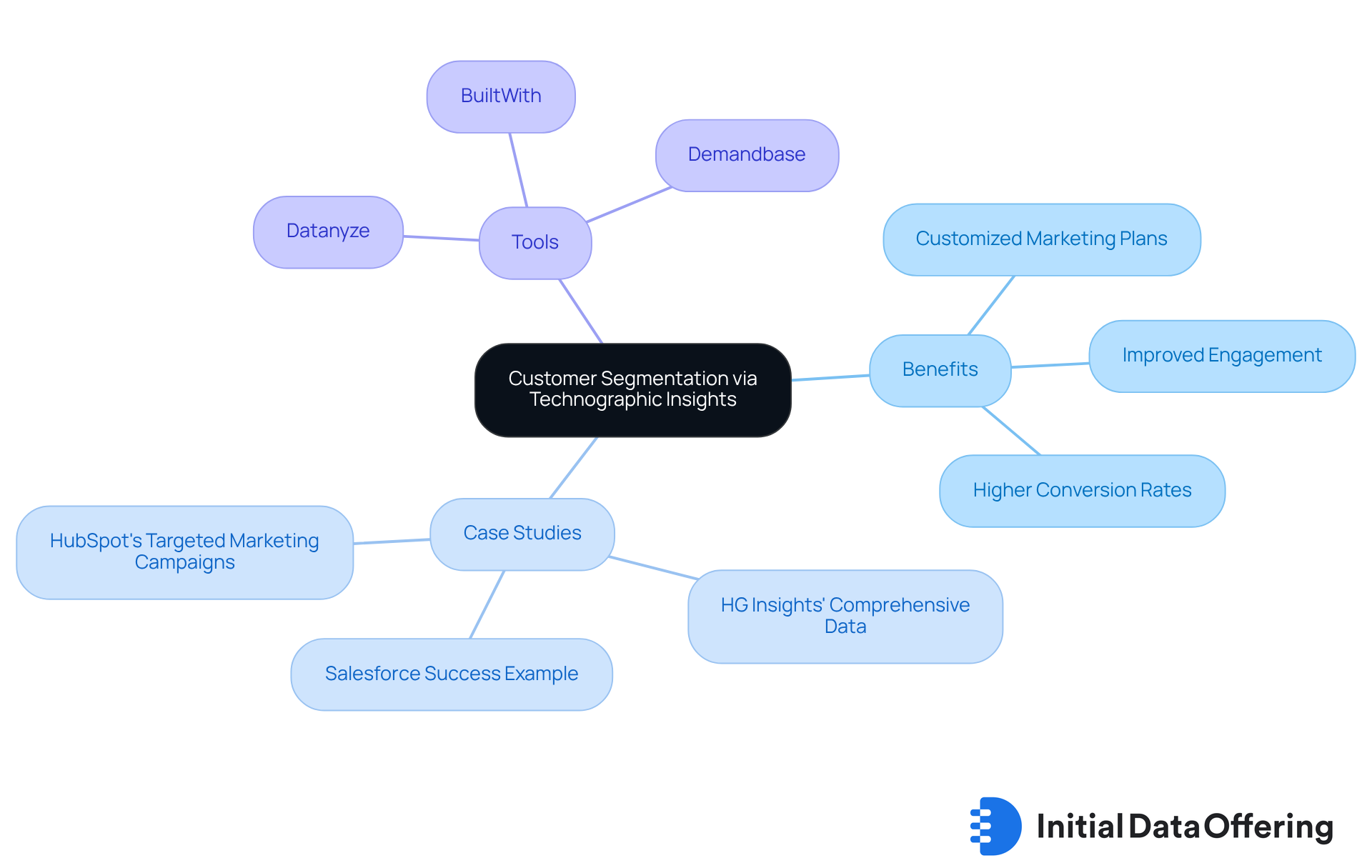
Account-Based Marketing: Leverage Technographic Insights for Targeted Outreach
Technographic insights significantly benefit account-based marketing (ABM). Understanding the technographic elements of target accounts is crucial for developing tailored outreach strategies that address specific challenges and needs. For instance, when a company discovers that a target account utilizes a competitor's software, it can customize its messaging to emphasize the benefits of switching to its own solution. This targeted approach not only enhances the likelihood of engagement but also strengthens relationships with key accounts. By leveraging these insights, companies can foster more meaningful connections and drive better results in their marketing efforts.

Competitor Analysis: Gain Insights into Market Dynamics
Technographic data acts as a powerful tool for analyzing competitors. By examining the technographic tools used by rivals, companies gain insights into their strategies, strengths, and weaknesses. This understanding informs product development, marketing strategies, and sales tactics.
For instance, if a competitor heavily invests in a particular innovation, a company can assess whether to engage in direct competition or identify an underserved niche. Such strategic insights are essential for sustaining a competitive advantage in the marketplace.
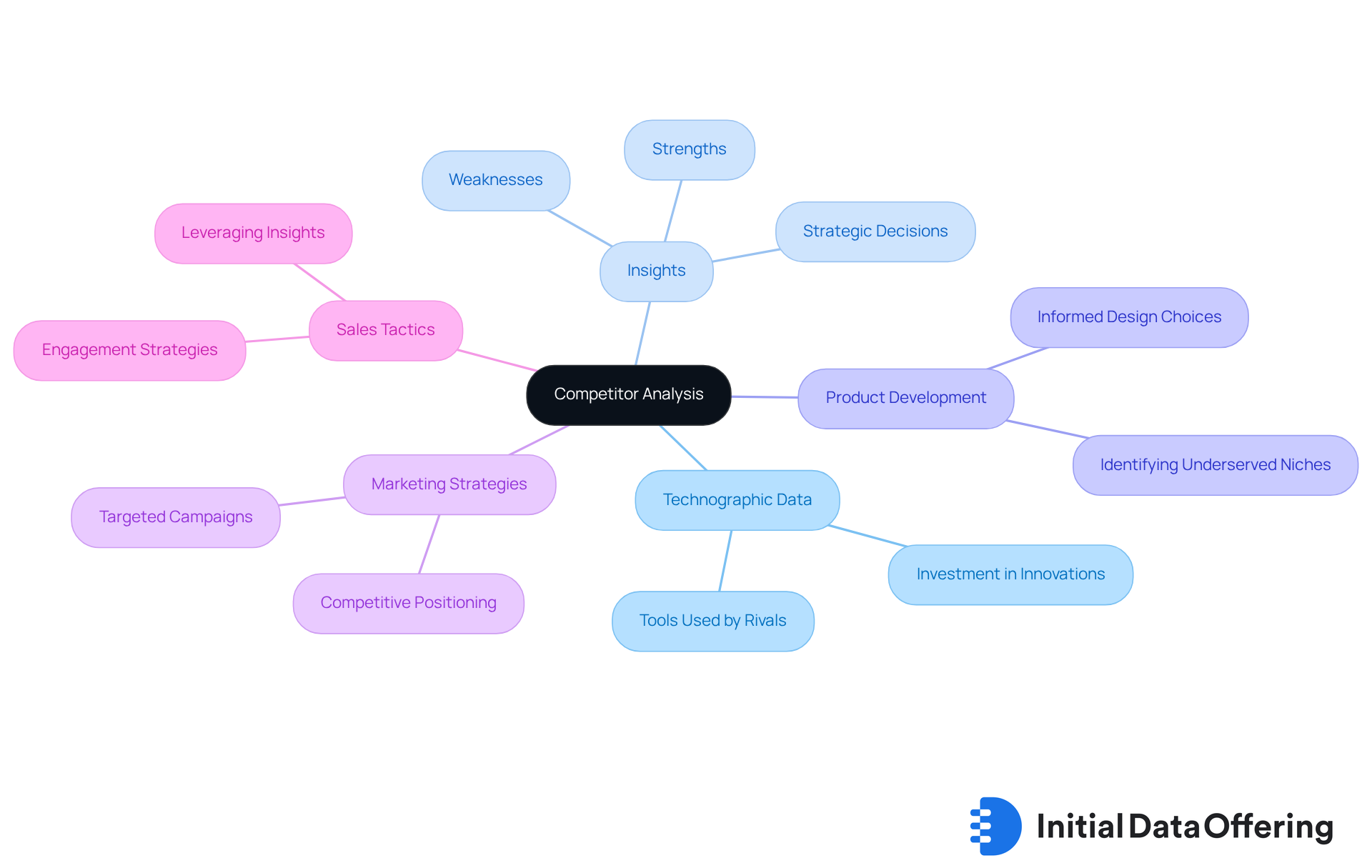
Forecasting: Predict Market Trends with Technographic Data
The utilization of technographic data significantly enhances the forecasting of market trends. By examining the technographic adoption rates of specific technologies across various industries, businesses can pinpoint emerging trends and anticipate market shifts. For instance, when a notable number of companies within a sector start embracing cloud-based solutions, it signals a potential industry-wide transition towards digital transformation. This foresight empowers businesses to proactively adjust their strategies, ensuring they remain relevant and competitive in an ever-evolving landscape.
How might your organization leverage this data to stay ahead of the curve?
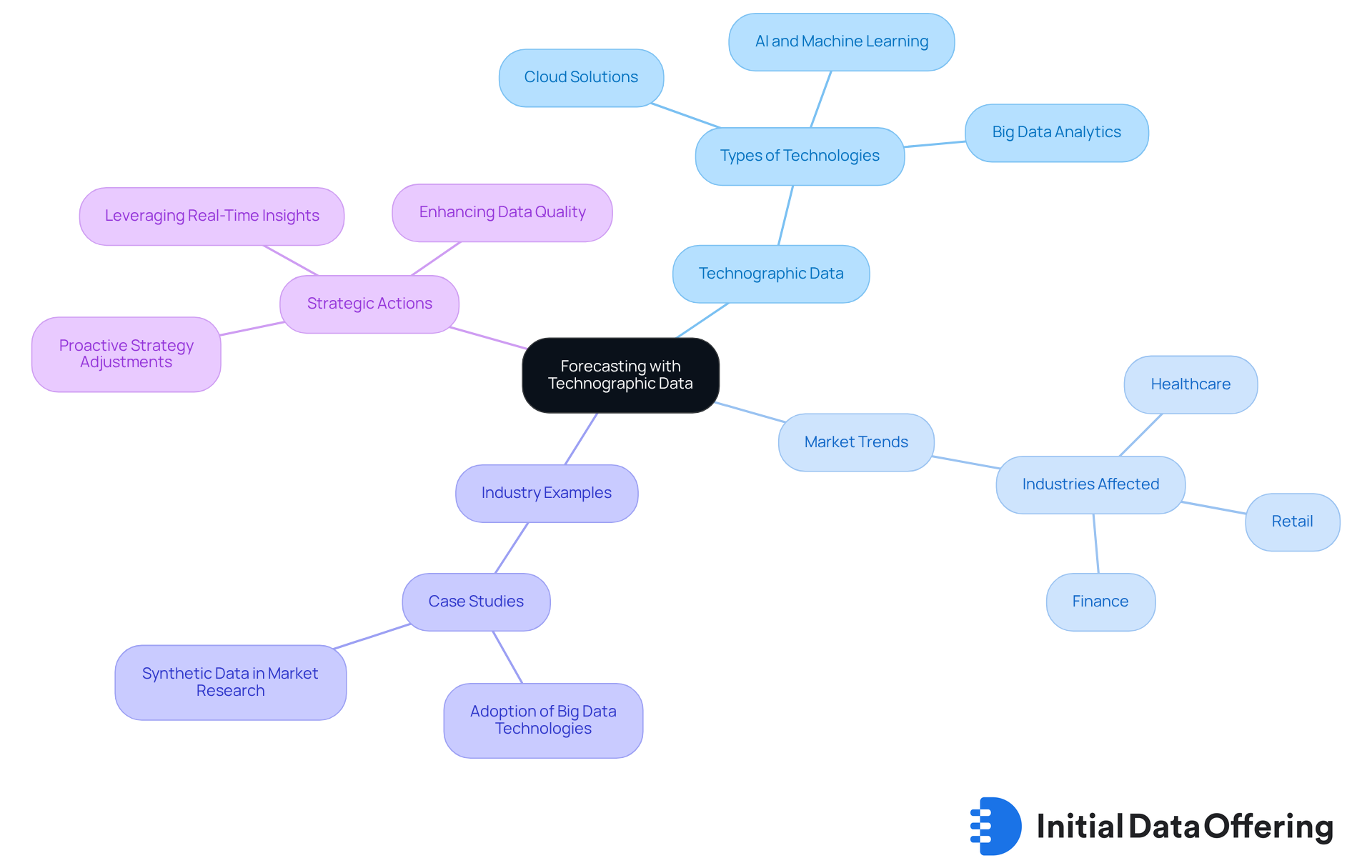
Optimize Sales Efforts: Enhance Strategies with Technographic Insights
Incorporating technology-related insights can significantly enhance sales efforts. By gaining a clear understanding of the technologies that prospects currently utilize, sales teams can customize their pitches to showcase how their solutions can seamlessly integrate with or improve existing tools. This tailored approach resonates more effectively with potential customers and reflects a comprehensive understanding of their specific needs. For instance, a sales representative might highlight the integration capabilities of their solution with the prospect's current software, thereby increasing its appeal.
Furthermore, leveraging technographic information allows sales teams to identify key decision-makers and influencers within target accounts. This enables them to craft messages that address unique challenges and objectives, fostering deeper engagement and potentially leading to higher conversion rates. How can your team utilize this level of personalization to enhance its outreach? Additionally, leveraging intent signals can assist sales teams in identifying accounts demonstrating interest through their content interactions, further refining their outreach strategies.
Key metrics such as engagement rates and conversion rates should be monitored to evaluate the effectiveness of these tailored sales pitches. Automated email campaigns triggered by specific prospect actions can ensure timely follow-ups, enhancing engagement and conversion rates. By aligning sales approaches with the technological environment of potential clients, organizations can create more impactful interactions that drive successful outcomes. As Yash Vardhan notes, 'By aligning your communication with where the prospect is in their journey, you make your interactions more relevant and impactful, increasing the likelihood of conversion.
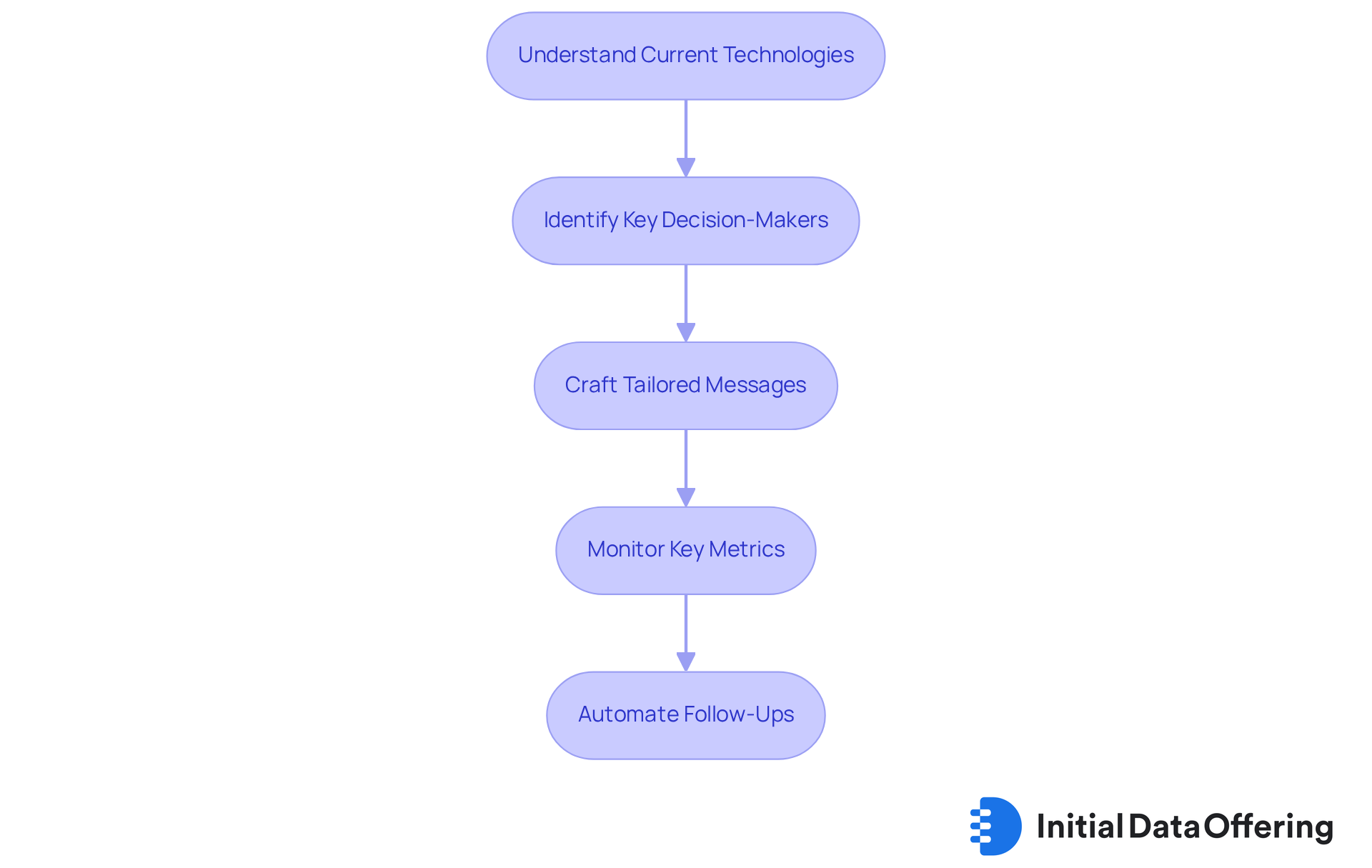
Improve Sales and Marketing Conversations: Utilize Technographic Data
Leveraging technographic data greatly improves collaboration between sales and marketing teams. By sharing insights into the tools employed by target accounts, both teams can align their strategies and messaging. This alignment ensures that marketing campaigns are informed by the sales team's experiences, fostering a more cohesive approach. For instance, when marketing identifies a trend in technology adoption, sales can tailor their outreach to highlight pertinent features, resulting in more impactful interactions with prospects. As Marie Hillion from Livestorm notes, "The biggest sales and marketing misalignment that I see is around the objectives, priorities, and metrics that are tracked on both sides." This emphasizes the necessity of integrating technological insights to bridge gaps and drive collective success.
Furthermore, consistent communication and collaboration can lead to improved lead quality and faster revenue growth. A notable statistic reveals that 91% of companies debate lead quality daily. By utilizing technographic data, teams can create a unified front that not only enhances their outreach efforts but also cultivates trust and rapport with potential clients. To further strengthen this collaboration, it is essential for both teams to define shared terms such as Marketing Qualified Lead (MQL) and Sales Qualified Lead (SQL), ensuring everyone is aligned on objectives that ideally roll up to revenue.
Adopting a unified tech stack can remove information silos and improve decision-making, facilitating effective collaboration among teams. Regular check-ins or collaborative meetings can also provide a structured approach to maintaining alignment and addressing any emerging challenges. How can your organization apply these insights to enhance collaboration? Consider the impact of shared definitions and consistent communication on your team's success.
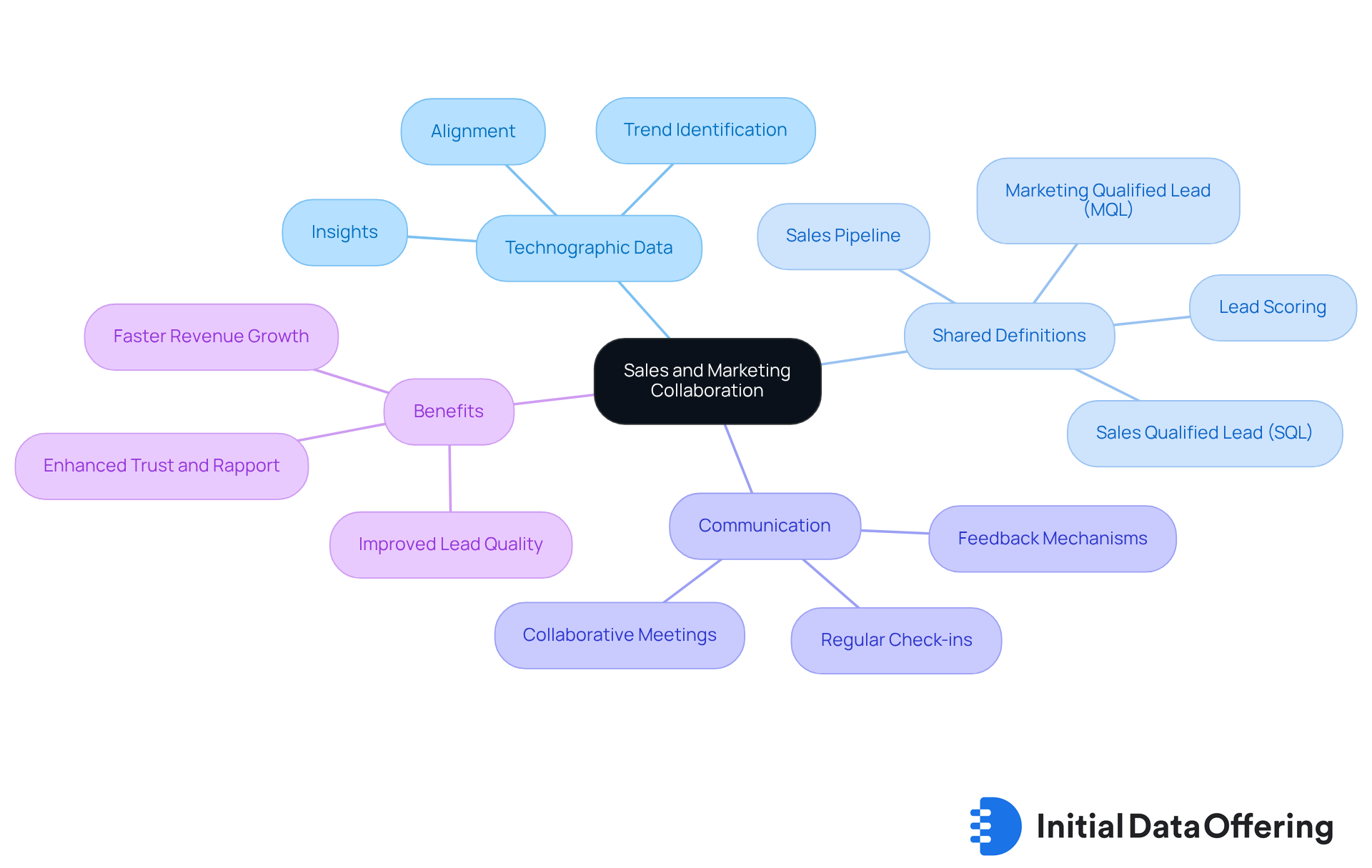
Expand into New Markets: Identify Opportunities with Technographic Data
Technographic insights play a crucial role in facilitating market growth by delivering data into the potential market landscape. By thoroughly analyzing this landscape, businesses can uncover gaps and opportunities for their products or services. For instance, if a company identifies a rising demand for a specific technology in a new region, it can adapt its offerings to meet that demand. This proactive approach not only streamlines market entry but also positions the business as a leader in addressing emerging needs. Moreover, leveraging data insights allows businesses to create customized marketing strategies that resonate with local audiences, enhancing their competitive advantage.
Understanding the preferences of potential customers enables businesses to refine their value propositions, ensuring they are well-prepared to meet specific market demands. Furthermore, information related to technographic data is vital for B2B firms as it informs marketing and sales strategies based on technology utilization. In fact, 41% of B2B marketers consider technological information essential for success. Tools like Clearbit or ZoomInfo can facilitate ongoing data enrichment, helping businesses stay informed about market dynamics.
To effectively incorporate tech-related information into market assessments, businesses should:
- Identify key innovations relevant to their target markets
- Consistently monitor changes in technology adoption
How can your organization leverage these insights to enhance its market strategy? By staying attuned to technological trends, businesses can not only respond to current demands but also anticipate future opportunities.
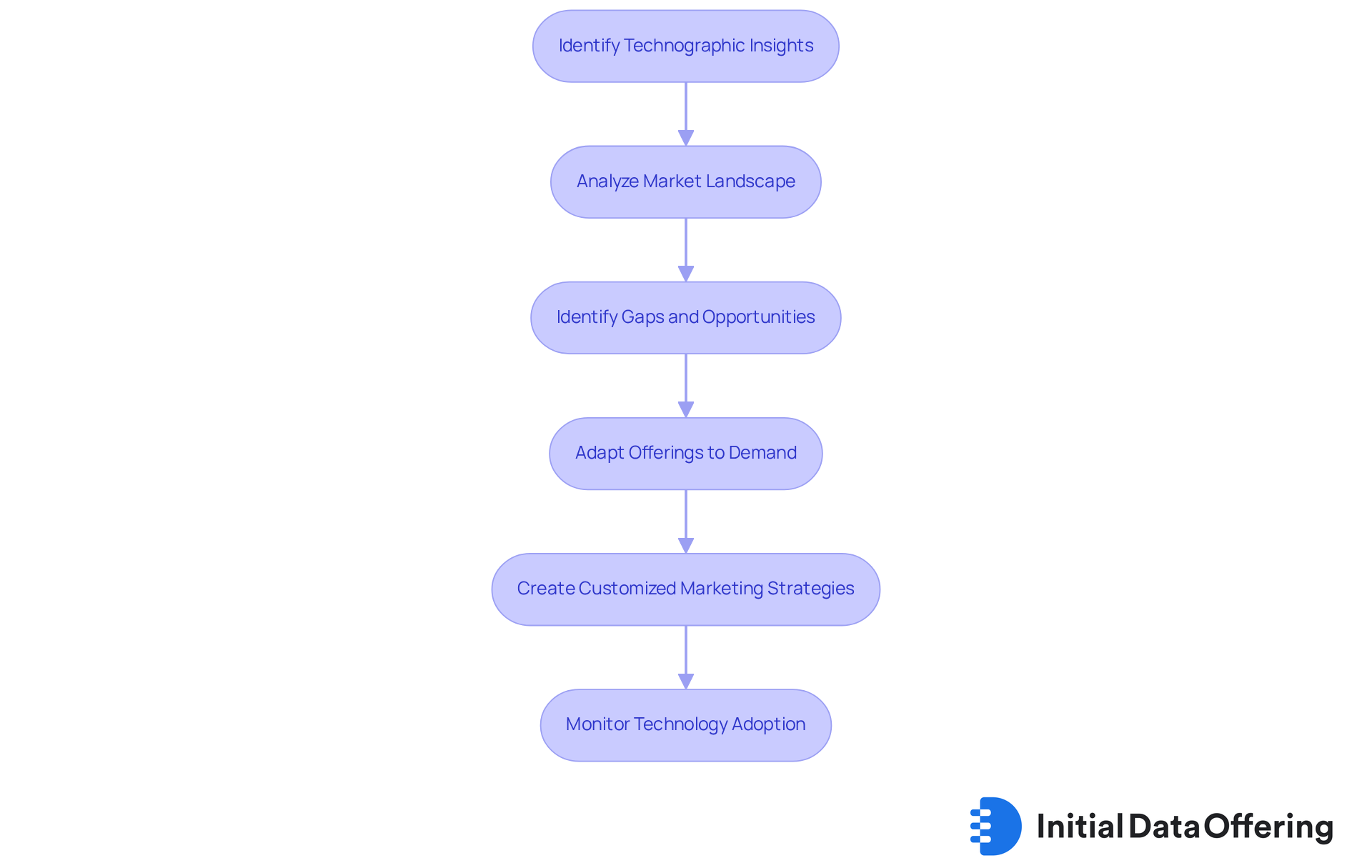
Scale Your Customer Base: Use Technographic Data for Growth
Utilizing technographic data serves as an effective strategy for expanding a customer base. By identifying organizations that can benefit from specific solutions based on their technographic usage of existing technology, businesses can streamline their outreach efforts. For example, a company specializing in cloud solutions can effectively target businesses still reliant on on-premises systems. This creates a compelling case for migration to more efficient cloud-based alternatives. Such a focused approach not only enhances the efficiency of sales initiatives but also significantly increases the likelihood of successful conversions.
As John Sculley pointed out, 'No significant marketing choices have ever been made on qualitative information,' underscoring the importance of evidence-based approaches. Furthermore, with 66% of B2B buyers more likely to open personalized emails, understanding the technographic details of potential customers enables more personalized and relevant engagement. This ultimately drives higher customer acquisition rates. Organizations that have effectively adopted this strategy report enhanced lead quality and conversion rates, demonstrating the concrete advantages of incorporating data insights into their marketing initiatives.
How could your organization leverage technographic data to improve outreach and conversion rates?
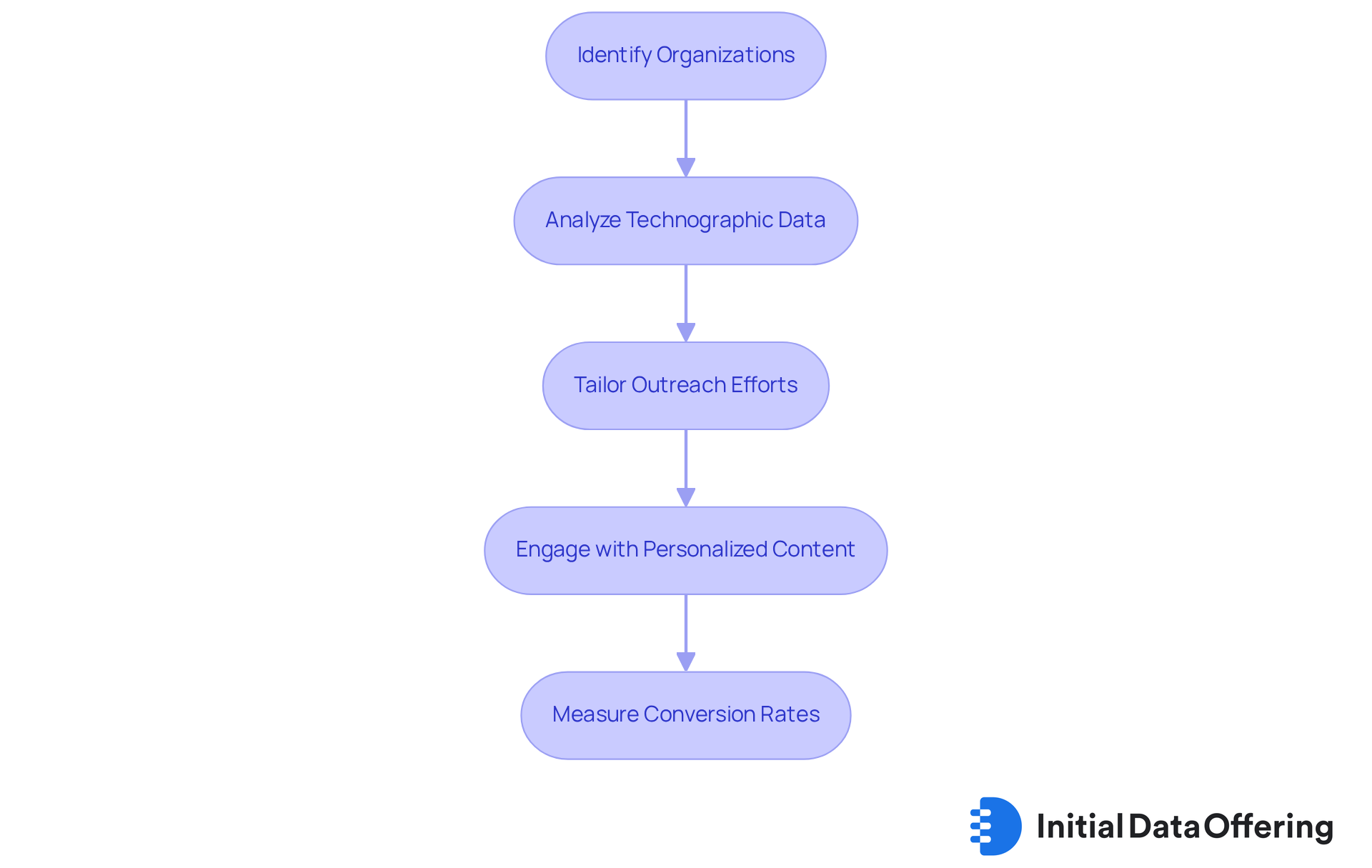
Gauge Quality of Technographic Data: Ensure Accuracy and Reliability
Assessing the quality of technographic data is essential for ensuring its effectiveness in decision-making. Companies must evaluate the precision, thoroughness, and promptness of the information they utilize. Regular audits and validation procedures serve as critical features that uphold information integrity. This practice not only fosters trust in insights but also enhances the confidence with which organizations can make decisions.
For example, implementing data quality checks allows companies to identify and rectify inaccuracies, ensuring that their marketing and sales strategies are grounded in reliable information.
How can your organization leverage these practices to improve decision-making? By prioritizing the integrity of technographic data, companies can significantly enhance their technographic strategies, leading to better outcomes and increased competitiveness.
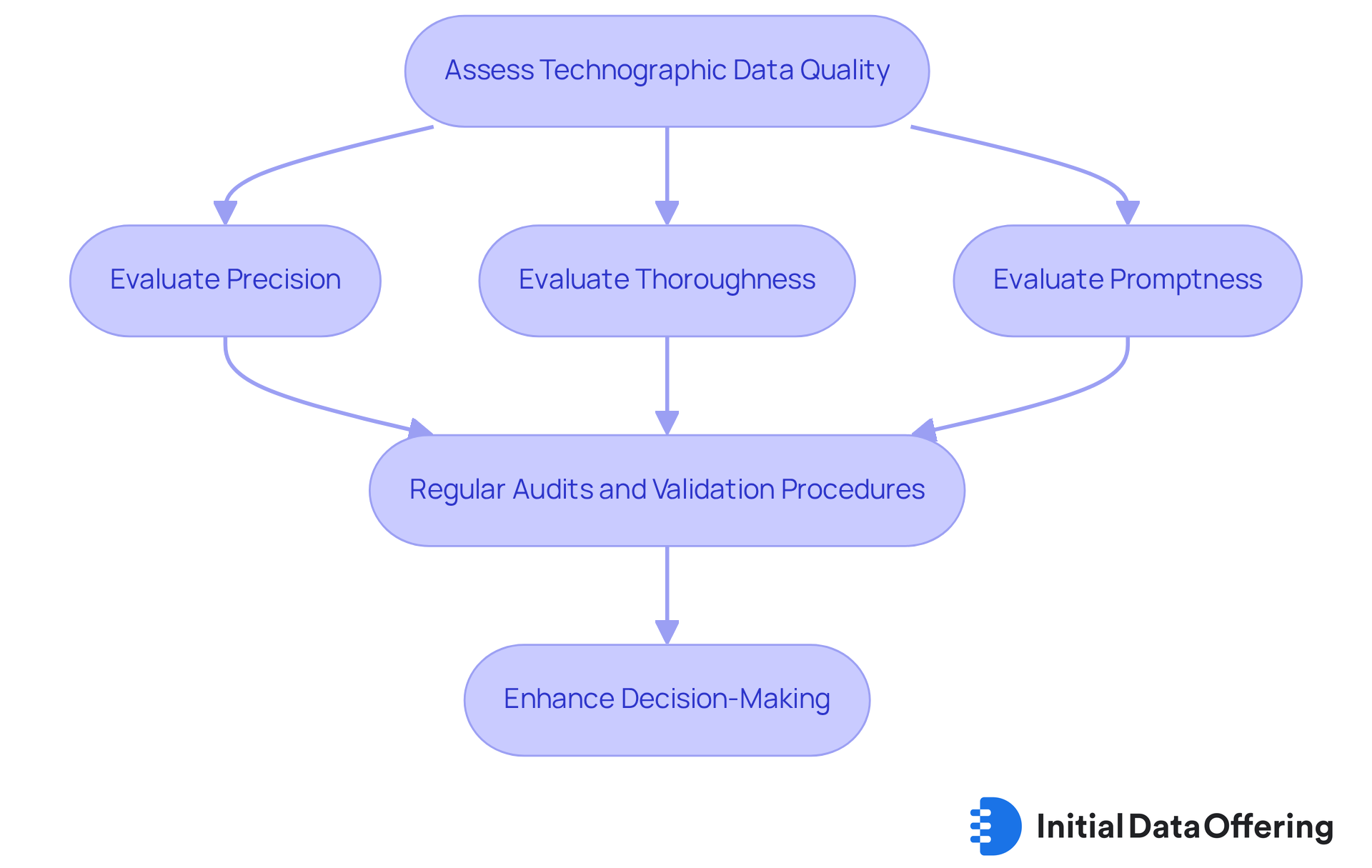
Conclusion
Leveraging technographic data is essential for businesses aiming to gain a competitive edge in today's rapidly evolving market landscape. By harnessing insights into the technologies utilized by potential clients, organizations can make informed decisions that enhance their marketing strategies, improve customer segmentation, and optimize sales efforts. This data-driven approach not only fosters personalized engagement but also facilitates strategic planning that aligns with market trends.
The article highlights several key strategies for utilizing technographic data effectively. From precise customer segmentation and account-based marketing to competitor analysis and market forecasting, each method underscores the importance of understanding the technological landscape. By implementing these strategies, businesses can enhance their outreach efforts, improve collaboration between sales and marketing teams, and ultimately drive growth by identifying new market opportunities.
In conclusion, the significance of technographic data cannot be overstated. As organizations strive to adapt to shifting market dynamics, embracing this data can lead to better decision-making and more impactful marketing initiatives. Companies are encouraged to explore how they can integrate technographic insights into their strategies, ensuring they remain responsive to customer needs and ahead of the competition.
Frequently Asked Questions
What is the Initial Data Offering (IDO)?
The Initial Data Offering (IDO) is a resource that provides access to extensive datasets offering in-depth insights into the toolsets utilized by various organizations, helping businesses make informed decisions aligned with market trends.
How do technographic datasets benefit B2B marketers?
Technographic datasets allow B2B marketers to identify competitive opportunities, with 66% using this data for strategic planning. Additionally, 75% of B2B customers expect personalized messaging based on their technology use, necessitating tailored marketing strategies.
What insights can be gained from technographic information?
Technographic information helps businesses understand competitors' technology utilization, identify potential clients, and enhance market positioning, ultimately aiding in making informed business decisions.
How can companies use technographic insights for customer segmentation?
Companies can leverage technographic insights to achieve precise customer segmentation by analyzing the tools used by prospective clients, which allows for the development of focused marketing plans that resonate with specific audience segments.
What are the benefits of customized marketing approaches using technographic data?
Customized marketing approaches using technographic data can significantly improve engagement and conversion rates. For example, Salesforce's targeted strategies led to an average 80% increase in engagement.
Why is understanding technographic information important for marketing specialists?
Understanding technographic information is crucial for marketing specialists to comprehend the tech environment of target accounts, enabling them to craft more accurate and efficient marketing and sales strategies.
How can technographic data enhance account-based marketing (ABM)?
Technographic insights enhance ABM by allowing companies to develop tailored outreach strategies that address specific challenges and needs of target accounts, leading to better engagement and stronger relationships.
What tools can provide insights into potential clients' tech stacks?
Tools such as Datanyze and BuiltWith provide valuable insights into the technology stacks of potential clients, helping companies refine their marketing strategies.
What is the projected trend for worldwide IT expenditure?
Worldwide IT expenditure is projected to increase by 9.3% in 2025, highlighting the growing significance of technology-related data in the current market environment.